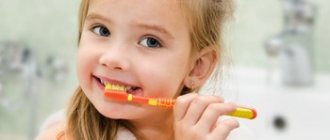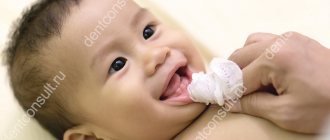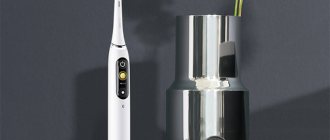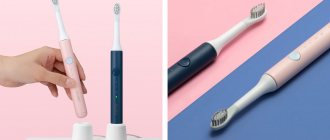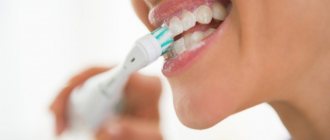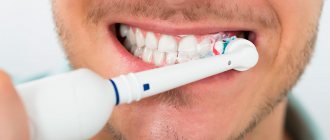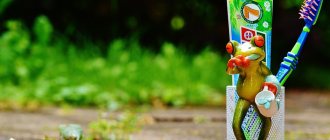Small children are afraid or simply do not want to brush their teeth, so unusual electric toothbrushes are bought for them. Their original design will turn ordinary teeth brushing into an interesting adventure.
In addition, the rapid rotation of the head of the electric device ensures thorough cleaning of teeth in hard-to-reach places, and the child practically does not have to make any effort to do this.
What parameters, besides design, should you pay attention to?
First of all, they take into account the age of the future owner, the degree of stiffness of the bristles and the type of nutrition.
They also take into account the comfort of the handle and the number of attachments that are provided in the kit. To make it easier for parents to choose an electric toothbrush for their child, we have prepared a list of basic criteria and a rating of the best electric toothbrushes according to the 2021 version in terms of price/quality ratio.
Rating of the TOP 15 best children's electric toothbrushes of 2021
| Place | Name | Price |
| TOP 3 best children's electric toothbrushes by price/quality for 2021 | ||
| 1 | CS Medica CS-562 Junior | Find out the price |
| 2 | Oral-B Vitality Kids Cars D100.413.2K | Find out the price |
| 3 | Hapica Kids | Find out the price |
| TOP 3 best children's electric toothbrushes from 1 year | ||
| 1 | MEGA Ten Kids Sonic Hamster | Find out the price |
| 2 | Philips Sonicare For Kids HX6311/07 | Find out the price |
| 3 | Revyline RL020 Kids (2 attachments) | Find out the price |
| TOP 3 best children's electric toothbrushes from 3 years old | ||
| 1 | CS Medica CS-462-P Kids | Find out the price |
| 2 | Oral-B Vitality Kids Star Wars D100.413.2KX | Find out the price |
| 3 | DBK-5RWG Panda | Find out the price |
| TOP 3 best children's electric toothbrushes from 5 years old | ||
| 1 | Hapica Baby | Find out the price |
| 2 | CS Medica CS-463-B Kids | Find out the price |
| 3 | Oral-B Mickey Kids | Find out the price |
| TOP 3 best children's electric toothbrushes from 7 years old | ||
| 1 | Oral-B Junior | Find out the price |
| 2 | Philips Sonicare For Kids HX6352/42 | Find out the price |
| 3 | Soocas C1 | Find out the price |
What to look for when choosing a sonic toothbrush for a child
In order not to get confused in front of dozens of items in the store, it is important to know what parameters to pay attention to. It is better to start using a sonic toothbrush at the age of 3; before this age, teach your child to use a regular one and always under the supervision of parents.
Bristle
For the youngest – 3-5 years – the softest bristles are marked on the packaging as “extra soft”. Starting from 5 years old, you can switch to soft bristles (labeled “soft”). After 12-14 years, the teeth are formed, the stiffness of the bristles is chosen based on the dentist’s recommendation and personal comfort.
Attention! Hard bristles will damage thin enamel and sensitive gums. Under no circumstances should children's teeth be brushed with medium or hard bristles.
Speed and modes
The faster the bristles move, the more effective the cleaning. But small users do not need such high speeds as adults.
Several cleaning modes are more convenient than just one; it is possible to adapt the brush to suit you. On children's devices this is not a mandatory function; most of them are designed for one operating mode.
How to choose a children's electric toothbrush?
An electric toothbrush is much better than a regular toothbrush at removing plaque. In addition, it allows cleaning in hard-to-reach places.
When choosing a brush, pay attention to:
- Child's age . The size of the nozzle used in the brush directly depends on it. Some models come with different sized attachments to make the device suitable for children of different ages.
- Handle . To make it more comfortable for the baby to hold the brush, it is better that its handle is made of rubberized material.
- Stiffness of the bristles . It is not recommended to buy brushes with hard bristles for children. Models with soft bristles clean teeth with sensitive enamel more gently and gently massage sore gums, so they are suitable for very young children. For older children, you can buy a brush with moderately soft bristles, because it better penetrates into the gaps between teeth and removes food debris.
- Type of food. Electric brushes can be powered by mains or batteries. It is better to give preference to the latter option, because such devices are safer and do not restrict the baby’s movements during hygiene procedures.
It is also advisable that the brush have a wear indicator on the attachments. This will make it easier for parents to control when to change the nozzle. In addition, attention is paid to the age range: it should be as narrow as possible. For example, if a toothbrush is intended for children 4-5 years old, it will have the optimal size and will be ideal for cleaning baby teeth. If the brush says it is for children 5-10 years old, it may be too small or large for the child.
Electric toothbrushes or manual ones?
In any case, a child should be able to use a manual brush - this is an important skill that develops motor skills. At an early age, up to 4 years, it is better to combine the use of manual and electric brushes.
Yes, you can brush your teeth equally effectively with an electric toothbrush and a manual toothbrush. However, even adults usually fail to follow the manual cleaning technique, let alone children. The task is further complicated by not only teaching, but also motivating the child to good hygiene. An electric brush is a simple and convenient way to achieve clean teeth with minimal effort.
And using an electric brush can be presented as a game. Bright colors, replaceable panels, funny stickers and a soft buzzing put older children in a positive mood, and allow little ones to cope with the fear of the dentist's office - the doctor's buzzing instruments will no longer seem so unfamiliar and unpleasant.
Children's hygiene. Do children need a sonic toothbrush?
It is important to start taking care of your child's teeth from the moment they erupt. Due to the misconception of many parents that baby teeth will soon fall out anyway, taking care of their health is not very important. This is completely unacceptable. Baby teeth damaged by infection can lead to the spread of the disease to future molars, and also contribute to the curvature of permanent teeth. In addition, the risk of developing diseases such as caries, stomatitis and pulpitis increases. Diction suffers, diseases of the gastrointestinal tract appear.
In childhood, the probability of caries occurring is close to 100%. This is due to the inability of the child’s body to resist bacteria, the structure and vulnerable structure of the tooth itself, and other factors. Prevention is the basis of a child’s oral health. Treatment of caries will cost much more. Thus, it is necessary to carry out hygienic oral care literally from the birth of the baby, and the first toothbrush for a child should be purchased no later than the first tooth erupts. This is necessary in order to prevent the formation of infections in the oral cavity and related diseases associated with improper dental care.
The main assistants in the process of cleaning the oral cavity are toothbrushes for children. But how to choose them correctly for your baby, what to look for when buying such hygiene products? We will answer these and other questions in our article.
Basic rules of oral hygiene for children:
- brush your teeth at least twice a day with special children's toothpaste and a soft brush, selected according to age
- change the brush (or attachments) at least once every 3 months
- use baby mouthwash
- Dental floss can become an indispensable aid in oral hygiene
- Every six months you should visit the pediatric dentist's office
Cleaning children's teeth has characteristics in each age period. Until the age of 15, a constant restructuring of the bite occurs; from six months to 2.5 years, a milk bite is formed, which at six years begins to change to a permanent one. At 13–14 years of age, there are normally no baby teeth left in the mouth and second molars grow in. Therefore, experts have developed hygiene products for each age period, taking into account its characteristics. The manufacturer is required to indicate the age category for which the product is intended, since the brushes will differ in the mechanism and force of influence, the stiffness of the bristles, and the material of manufacture.
0-1 year . It is recommended that children brush their teeth from the age of six months, when teething begins. At this age, cleaning is carried out by the mother using a bandage wrapped around a finger and moistened with water in a weak saline solution, special napkins or a finger brush.
1-3 years. After the first year of life, it is recommended to accustom your baby to oral hygiene. To do this, you can take it with you to the bathroom and brush your teeth together as a game. You need to use a children's toothbrush and toothpaste, which are gentle. To do this, it is better to use a manual (classic) toothbrush with soft bristles and a short, thick handle. In this case, you need to start with 15-20 seconds for each cleaning, gradually increasing the duration. The main task of the mother at the stage of introducing the child to the brush is to awaken interest in this activity. This can be done by showing by example or by playing with a child. There are devices that attract the baby's attention to the brushing process, for example, a children's hourglass (for maintaining the required brushing time) or funny toothbrush cases in the shape of animals. The dosage of the paste should not exceed the size of the nail on the child’s little finger. The baby will be more willing to brush his teeth with a special children's toothpaste with a pleasant taste and aroma. Additionally, teach children to rinse their mouths after every meal.
3-6 years. From the age of three, you can use an electric toothbrush for children. At this age, children already have sufficient skills and can safely brush their teeth under the supervision of an adult. Many dentists, in a situation when you are not at home, recommend using sugar-free children's chewing gum, thereby restoring the alkaline balance. However, the process of chewing it should not exceed 10 - 15 minutes.
6-18 years old. You can use sonic, ultrasonic children's brushes, mouth rinses, threads, and children's irrigators.
Children's oral hygiene is important and necessary, but teaching a child to brush their teeth correctly and devote enough time to it is not easy. Therefore, parents are increasingly thinking about replacing a regular toothbrush with an electric one. There are various models on the market - battery-powered, rechargeable, with a special handle, and innovative technology. But the most popular is the children's sonic toothbrush. Since this new product has been released not so long ago, many parents are concerned with questions: what is a children's sonic brush, is it dangerous for teeth? Modern manufacturers offer a wide selection of devices for children, and they should be chosen carefully.
Sound models work on vibrational waves, that is, cleansing is performed not only by mechanical sweeping. The sonic brush contains a high-frequency generator that produces sound vibration waves. About 18,000 oscillatory movements occur per minute, which not only remove plaque, but also help eliminate bacteria. Before using a new brush, you must rinse it thoroughly in water; the product must not be boiled. It is recommended to store the brush in an upright position; the head should be closed with a cap or case. It is better to change brush heads every 3 months.
Things to consider when choosing a baby sonic brush:
- Age characteristics. Children's brushes always indicate the age for which they are designed.
- The stiffness of the bristles. The bristles should be soft or medium hard
- Speed mode. Children's brushes have different cleaning modes and the speed is lower than for adults
- Lever. It should be comfortable for the child and have a rubber studded coating to prevent slipping during use.
- The brush should be able to change attachments. The nozzles should be small (Kids), with soft bristles
- Water resistance. Electric brushes with an inductively charged device are not afraid of complete immersion in water; a child can drop the device into water without damaging it
- Built-in timer. Allows you to keep track of cleaning time
- Additional functions. For example, communication with a smartphone, an application with games, ringtones
- Attractive to a child. The presence of cheerful colors, stickers, images of fairy-tale characters
Advantages of children's sonic brushes:
- the ability to brush teeth in hard-to-reach places. Qualitatively and effectively cleans teeth of all types of dental deposits
- not only remove plaque, but also help eliminate bacteria
- tooth brushing time is reduced. For a child who quickly gets bored with the monotonous cleaning process, this is very important.
- ease of use: the child does not need to make any effort, since the toothbrushes do everything themselves
- increases interest in dental hygiene in children, the image in the form of a favorite character will additionally attract attention and make the brush look like a toy
- setting the brush operating mode allows you to monitor the optimal pressure on the gums and teeth
- some models are equipped with a special digital reminder to replace attachments or batteries
The disadvantages include:
- impossibility of use for certain diseases (acute inflammatory diseases of the oral cavity, gum disease, heart disease in the acute phase or the presence of a pacemaker, the presence of thin and fragile enamel, a large amount of dental plaque, diseases of the hard tissues of teeth)
- Despite the obvious advantages of a sonic brush over a regular one, you should consult with an experienced pediatric dentist before purchasing
- the need to alternate with a manual brush in the presence of thin enamel
- the price of sonic toothbrushes for children is higher than that of classic ones
Choosing your first sonic toothbrush is a very important decision. There are enough children's models on the market, both very expensive and quite affordable for any family. You can understand this diversity by studying the parameters of the brushes themselves.
Manufacturers produce devices even for the youngest children, but it is recommended to use an electric brush after 3 years.
Hapica is one of the most popular children's sonic toothbrushes. Available in different age versions: Baby (from 1 to 6 years), Kids (from 3 to 10 years). The brush is very comfortable, has a bright and interesting design, light weight (58 grams), and a small head with soft bristles. 1500 atraumatic bristles made of soft and thin DuPont Tynex nylon will gently clean the entire surface of the tooth without damaging the thin enamel of baby teeth and delicate gums. The noise level during operation is 47 dB, which corresponds to the noise level of a quiet conversation. One AA battery powers the brush for more than three months in daily brushing mode for three minutes twice a day.
Philips HX 6311/07 For Kids - for children from four years old. The Kid-timer feature gradually increases brushing time over 90 days, aiming for the dentist-recommended 2 minutes. Has a built-in music timer. Funny melodies turn brushing your teeth into an interesting game and teach your baby how to properly brush his teeth. 2 child-safe cleaning modes designed for different ages, providing a gentle clean that's perfect for different ages. There is a gentle cleaning mode for children aged 4 years and over and an intensive cleaning mode for children aged 7 years and older. Includes 8 reusable front panel stickers. Comfortable rubberized handle, ergonomic design.
Smart toothbrush Kolibree (Hummingbird) V1 for children from 6 years old and adults. This is the world's first sonic toothbrush with artificial intelligence, Bluetooth support and unique technology to analyze the process of brushing your teeth. The Hummingbird Brush remembers how long and how thoroughly you brush each tooth and gums, and displays your progress on a mobile dashboard on your smartphone. Soft bristles with rounded ends prevent damage to children's sensitive teeth and gums. The stylish handle design is comfortable for adults and children's hands. Weight only 80 grams. Motion sensors built into the Kolibri v1 brush turn the brush into a game controller. Using the Hummingbird brush with a phone or tablet connected to it via Bluetooth allows your child to take part in a game designed to improve their oral brushing technique. The game form allows you to keep the child’s attention, so the duration of the cleaning process reaches 2 minutes. You can also download additional games from Google Play or the App Store, absolutely free.
After 13–14 years of age, you can use an adult sonic brush.
Choosing the right children's toothbrush will help develop your child's dental care skills. After all, as healthy as baby teeth are, the molars will be as strong. Children do not like to brush their teeth and do it reluctantly. With an electric brush, a child in a short period of time is able to clean his teeth well in a way that he could not do with a regular one. This is the key to high-quality and effective cleaning even in hard-to-reach places. Using a sonic electric toothbrush encourages children to brush their teeth regularly.
When purchasing, it is important to pay attention to the availability of attachments and special modes for children of different ages. The presence of a timer with sound signals in the form of a melody will arouse the child’s interest, and the ergonomic short handle will prevent the brush from slipping out of the hand. According to dentists, a child can use an electric toothbrush from the age of three under adult supervision. You need to buy a special model that is intended for use by children. You need to remember that the enamel of children's teeth is more capricious, so you need to use brushes very carefully. According to dentists, such devices can clean teeth more effectively and at the same time protect gums from possible diseases, provided they are properly cleaned. The variety of children's electric toothbrushes allows you to choose a model to suit every taste.
If you have any questions, just call us at
Types of toothbrushes
Currently, there are 4 main types of toothbrushes: mechanical, electric, sonic and ultrasonic. In our rating we will consider only the first 3 types, because... Ultrasound devices are not recommended for children. So, more details about each:
- mechanical.
Dental care tools familiar to all of us since childhood. They are most often inexpensive and do not require any additional investments (purchase of batteries or replacement attachments).
- electric.
This type of brush is equipped with a small electric motor that is powered by a battery or replaceable batteries. Cleaning of teeth occurs due to rotational and reciprocating movements performed by the head with bristles. It is thanks to such movements that such brushes effectively cope with plaque deposits and food debris. Most models are equipped with timers that are responsible for the end of cleaning; there may be several cleaning modes and other improvements.
- sound.
They, like electric ones, are powered by a battery or batteries, but the principle of operation is slightly different. The cleaning head does not rotate, but vibrates, emitting sound waves. It is due to vibration that cleansing occurs even in hard-to-reach areas.
How to choose
The child needs to purchase a separate brush, specially made for children. In addition, when choosing, you need to pay attention to several parameters:
- It is better to have a charge indicator, then the device will not turn off unexpectedly;
- the child does not need many modes and additional functions;
- the handle should be comfortable and non-slip.
From one year to 3 years
Dentists recommend purchasing such a brush for a child as early as 2-3 years old, when all the teeth have grown. Another condition for its effective use is that the baby should not be afraid of the buzzing sound that it makes when working. When choosing, you need to pay attention to the labeling; the age must be indicated. A brush for such a baby should be small, light, with soft bristles. This can be recognized by the inscription extra soft.
From 3 years to 5 years
Typically, it is at this age that a child is first given an electric toothbrush. It will make it easier to get him used to brushing his teeth, as it will be perceived as a game. It is recommended to choose standard models with a small head and soft bristles; they will be marked extra soft.
From 5 years to 7 years
At this age, the child begins to use this brush more often. It may be larger in size, but still brightly decorated. You need to choose a soft head, the inscription will be soft.
From 7 years
Children over 7 years old are allowed to use these brushes independently. They no longer have to choose very bright models, since they are used to caring for their oral cavity every day. But the brush should still be light, with a soft head.
Contraindications for children's electric brushes
Almost all children can use electric toothbrushes, but you should consult your dentist before using them. He must exclude contraindications to the use of these devices. There are few of them:
- Caries at the white spot stage. They indicate areas of remineralization. An electric brush can worsen the condition, so it is better to use a regular brush until it is completely cured.
- Inflammatory gum diseases. An electric toothbrush affects the enamel not only mechanically, but also with sound waves or vibration. It is much stronger than when brushing your teeth with a manual brush. If your gums are inflamed, they will hurt and bleed. An electric brush can make the situation worse.
Electric brushes are not contraindicated in the presence of orthodontic structures and fillings. However, you will need a special attachment.
The bristles of a toothbrush have a limited lifespan. The nozzles will have to be changed every 3-4 months. If it becomes unusable ahead of schedule, throw it away and buy a new one. A large selection of electric brushes for children is presented in our online store. You can order both the models described above and other models.
